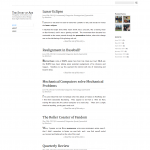I suppose, seeing as though I’m a web developer, my first post on my new WordPress blog should be about WordPress.
I first encountered WordPress a number of years ago when I was working on a project that never took off. I was intrigued by the idea of a simple interface for bloggers, and especially the multi-blog features.
Last year I took on a large project that I ended up basing on the Joomla framework. That was a very interesting experience. I found some parts of Joomla to be fantastic for giving me a platform on which to create, but other times it was a stifling mass of code. In particular, I needed to create registration forms with numerous fields. I spent a significant amount of time downloading, installing, testing, and rejecting various Joomla form components. I decided that I didn’t like any of them. Mostly, it was the clunky way you created new forms. They were trying so hard to create dynamic interfaces, but none of them were something I felt comfortable putting in front of the client without giving them a week long seminar in how to use it.
In the end, I created a ridiculously un-dynamic component, but because I created it from the beginning with the needs of this specific client in mind, it is able to do exactly what I need from it. (Their latest ideas to develop the site may require me to rewrite large portions of the code, but it has stood up quite well over the past year plus that it has been online.)
After my experience with Joomla, I decided to experiment a little with Drupal. I hit a wall there. It is entirely likely that had I not been so picky about how I wanted the site to work I may have had more success. But I wasn’t, so I didn’t.
Which leads me back to WordPress. In setting up this blog, I really enjoyed the ease with which I could add and remove plugins and themes. Even creating my own plugin was quite a pleasant experience. Granted I just created a little gallery widget to show random pictures from the blog and most importantly – link to their associated post, but just a simple thing like creating a widget options form to change the title of the Widget was a breeze.
I’ve built websites starting with a blank notepad window, so I can really appreciate what these CMS’ offer. However, it’s important to keep in mind that they serve different needs. As I see it, there is a trade off between flexibility and ease of use. The easiest website to set up, for me, has been with WordPress, but I knew coming in that it really needed to be formatted as a blog, without the bells and/or whistles of other types of websites. Joomla definitely gave me a solid ground to work from, but still let me go off in different directions. The small glimpse of Drupal that I got showed me a very dynamic and robust system, that was just too unstructured for that project, but I could see myself trying Drupal again someday.
There is still something worm and fuzzy about creating something from scratch.
**As a side note: I’ve begun working with GIT, and I think it may become a more permanent part of my work flow. One of the really nice things about WordPress is the way the system keeps plugins and themes contained, as opposed to Joomla where parts of the component are in the "component" folder and some are in the "administrator/component" folder. I would like to work with my components at GIT repositories, but I’m having trouble conceptualizing how that would work. (On a live site I could just re-install or upgrade the component, but that’s very inefficient for a testing server.) Any suggestions?





